Fusion 360 first impressions
← Back to Kevin's homepagePublished: 2019 March 27Last updated: 2019 April 10My first impressions on Fusion 360, in the context of modeling and building this chair:

I’m a CAD advanced amateur: I first learned SolidWorks to laser cut tetrominoes, then I used Autodesk Inventor extensively to design and CNC mill my cell phone explore workshop designs, and generate construction plans for a sauna (writeup on that TBD). Overall, I’ve probably spent just a hundred hours using CAD packages, learning via Lynda.com video training courses and relentless clicking through menus.
I was happy with Inventor, but unfortunately it’s Windows-only and while traveling I only have my Mac laptop. Since Fusion 360 does work on OS X (and because Autodesk is pushing it hard into the hobbyist market) I thought it’d be worth exploring.
Install + dealing with the cloud
I first installed Fusion 360 via the Mac App Store, but this turned out to have OS X sandbox limitations that prevented plugins from fully accessing the filesystem. So I reinstalled Fusion 360 directly from Autodesk’s website (Version 2.0.5357) Apparently this includes a 30 day trial; no idea what will happen after that, but it’s good motivation to finish the chair I’m making.
Sometimes Fusion 360 starts in 5 seconds; other times it literally takes a few minutes, with Activity Monitor reporting “Application Not Responding”. Have faith (or go make a coffee).
I told Fusion my project was “chair2” and it opened a tab called “chair2 v0”. That’s cool, sounds like there’s some built in versioning.
However, at some point that turned into “chair2 v0 v0”, at which point I decided to take everything offline before Fusion 360 lost my work. The toggle is inexplicably hidden behind a clock:
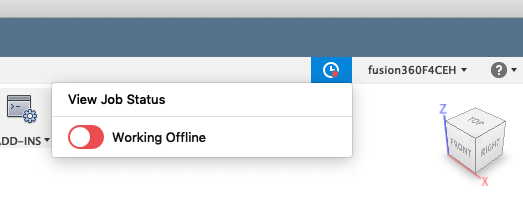
I handle versioning / backups myself by using File > Export and checking Save to my computer:

Note that unchecking Save to my computer automatically checks Save to a project in the cloud, which is then impossible to uncheck.
If this happens, close the export and start over.
(Or export to the cloud while working offline? No idea what happens there.)
Initial impressions
Note: Craig Andera wrote in to clarify some of the issues I ran into below. You can check out our conversation for details.
Unlike SolidWorks and Inventor’s “parts” and “assemblies”, Fusion just has “components” which can be nested within each other. This seems nice.
Parameters have to be defined in advance (
Modify > Change Parameters); they cannot be created on the fly by dimensioning something as, e.g.,width = 10cmThis is infuriating, especially since there’s no way to leave the parameters window open while editing features/sketches.I’m not sure how to tell when sketch geometry is under-constrained (unlike Inventor, which helpfully draws constrained points/lines in purple and unconstrained in green). It wouldn’t surprise me if my chair has a few underconstrained bits, which makes it feel even more necessary to manually backup/version things, lest an accidental drag/drop mess something up.
(Update: Turns out I failed to constrain the initial sketch point to the origin, so everything was under-constrained. Dimensioning part of the sketch to the origin or adding a “Fix” constraint turns lots of lines black i.e. fully-constrained.)
In Fusion, the history of all operations are listed together at the bottom of the screen, rather than as a tree tied to each part. As far as I can tell, there’s no way to label operations, which makes me nervous about doing anything complex — my simple chair of 4 unique parts is basically illegible:

The history can be filtered by “activating” a component (click the circle next to its name):

(Update: Pressing
Shift-Ncolor codes components and bits in the timeline, which helps a bit — still wish I had a visible operation labels, though.)However, hovering over the (unnameable) operations doesn’t provide any clues as to what’s involved. One has to actually double-click to re-edit the feature to see the involved parties (here, mirroring a cut from the top of the cross member to the bottom):

(Aside: In taking these screenshots I realized that the mirror operation did not actually mirror the cut feature. After several attempts to fix this, I gave up and mirrored the cut line in the sketch rather than mirroring the cut/extrude feature.)
I didn’t use the CAM or drawing tools, so can’t speak to them, but overall, Fusion 360 is definitely sufficient for modeling a simple chair:
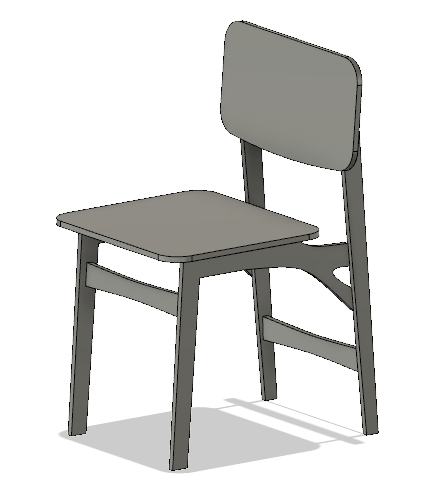
Never having used Fusion 360 before, this took me about 4 hours to model.
My focus for this project was to establish process, so I didn’t worry too much about the design — it’s pretty much copied from a photo of Hitoshi Makino’s “RECO” chair (which I’d link to directly, but their website is made of, uh, JavaScript.)
Creating a chair template: drawing mode fail
I planned to cut my chair from a sheet of plywood / OSB and assemble with dowels (flatpack-style). Initially, my plan was to create a sheet-sized PDF (4’ x 8’) from Fusion 360, then find some PDF utility to split across a home-printable paper size (i.e., 8.5" x 11").
Unfortunately, Fusion 360’s drawing environment is quite limited:
It’s tedious to import individual components and position them within the drawing sheet.
If a component face isn’t parallel with a cardinal plane, then you must “look at” the face in the design and create a “named view”:
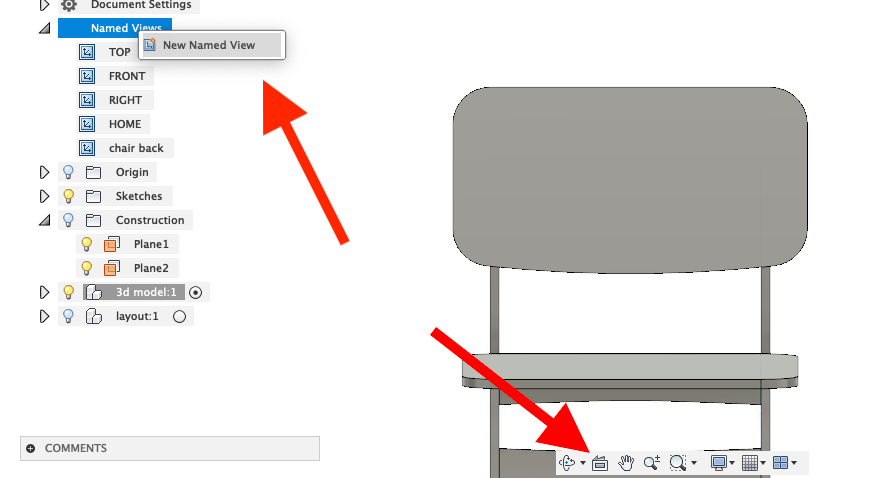
then use this view in the drawing
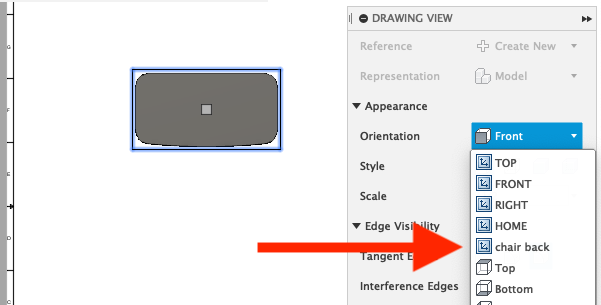
The deal breaker is that there is no custom drawing size:
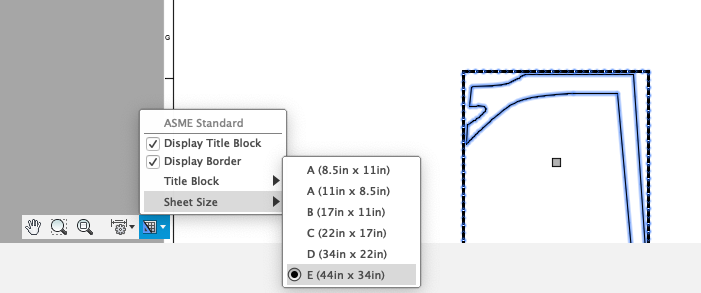
This makes it impossible to create 1:1 scale drawings for usage as templates; perhaps one could workaround by manually creating a scaled drawing and including a boundary sketch to match the desired sheet good aspect ratio, but at that point how much is the software really helping?
Creating a chair template in model mode
Fusion 360 sketches have an “export to DXF” option, so instead of creating a drawing I tried copying my chair components, aligning over a virtual sheet, and then projecting the geometry onto a sketch that could be exported:

To make the parts co-planar, I found the Modify > Align tool to be much faster than using the formal Assemble > Joint tool.
See this video for details.
Unfortunately, I ran into trouble when trying to convert the exported DXF to a PDF:
https://www.dxfconverter.org/ made it square and added whitespace.
https://www.zamzar.com/convert/dxf-to-pdf/ messed up the dimensions.
LibreCAD: Exported blank PDF; I also couldn’t figure out how to center artwork and set final paper size.
QCAD trial: Initially it exports a blank PDF; after more fiddling (setting paper size, layer color, and line width; removing paper margins from QCAD preferences) it seemed to export correctly. However, right before going to print I realized that it actually messed up a drawing curve (QCAD on right):
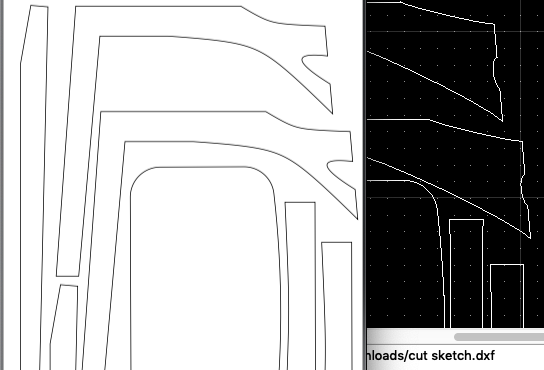
(This was QCAD version 3.22.0, built 2019 March 1.)
I then gave up on DXF export and instead turned to the Shaper Utilities plugin, which exports to SVG.
I tried to clean up the SVG and export to PDF using Sketch (Bohemian Coding’s graphic design tool), but this failed because:
- Shaper exports the SVG with centimeter units, which Sketch silently truncates to integers and then calls pixels
- Sketch doesn’t seem to process
vector-effect="non-scaling-stroke", which together with the truncation gives a 2 cm line width.
Finally, I decided to just process the SVG myself, since it’s a format I understand from years of working on the web.
First I ran:
sed -i '' s/"rgb(100,100,100)"/"black"/g chair.svg
to turn the cut lines black, then converted to PDF with the appropriately-named Chrome headless render PDF command line tool:
chrome-headless-render-pdf --no-margins --paper-width 24 --paper-height 48 --url file://`pwd`/chair.svg --pdf chair.pdf
At this point, I’d had my fill of computering, so instead of trying to tile the PDF to something I could print myself, I just went to a print shop and had them print it out on a single sheet of paper. (By luck, it turns out that 24" is a common paper roll width.)
I then glued the template to a quarter sheet of ½" OSB and cut it out with a jigsaw on the back steps of my AirBNB:
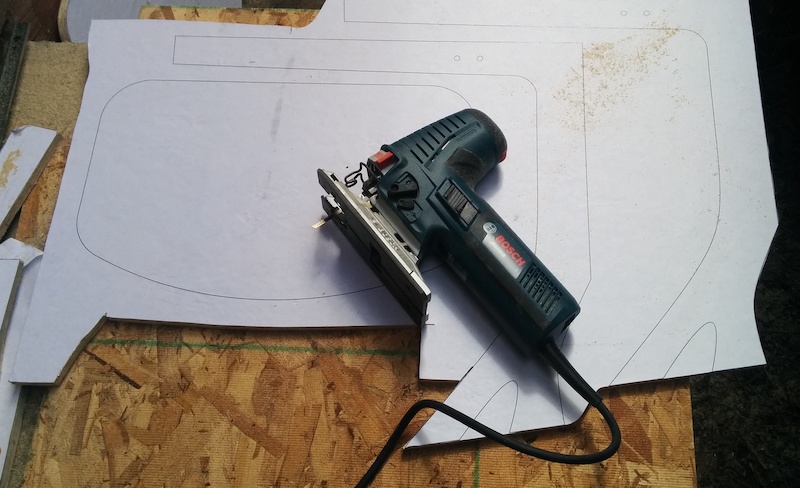
I then assembled the pieces using glue and dowels to form a chair:

Epilogue
Alas, Fusion 360 broke off our relationship suddenly when I tried to work at a no-wifi coffee shop:


As someone who has built in the middle of the woods, I can’t justify paying for software that refuses to work offline.
I’ve since switched back to my old copy of Inventor, which actually runs more smoothly in a Parallels VM than Fusion 360 ever did natively. Plus, since the VM has never seen the Internet and works fine, I know it’ll work just fine 10 years from now — which is more than I can say for Fusion.